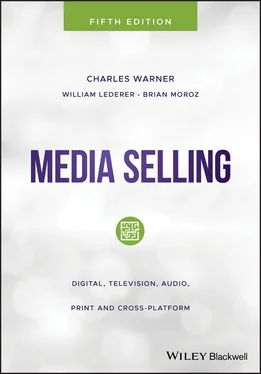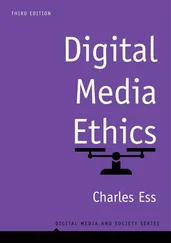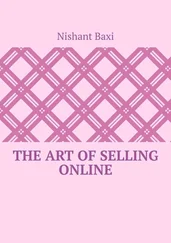Personal selling without tricks or manipulation – with authenticity – is essential in order to build and maintain relationships based on trust.
The imperative of honesty, integrity, and ethics in selling in this era of government, corporate, and media misdeeds and erosion of confidence in the media, and in this new era of social media in which it is virtually impossible to erase the digital footprint of misdeeds or impulsive comments.
Attitudes control successful sales performance, and attitudes are controllable by using sound goals and objectives to motivate salespeople and help them achieve their dreams.
Developing emotional and social intelligence – self‐awareness, self‐management, social awareness, and relationship management – is necessary for success in educating customers and helping them.
Solution and insight educating and selling means selling solutions to marketing and advertising problems.
Because some of the in‐person business in the media is still conducted by means of negotiating, today’s successful media salespeople must be competent negotiators.
Understanding the basic concepts of marketing and advertising is crucial to developing appropriate solutions and insights.
The fifth edition of Media Selling has several unique features:
A fully integrated and organized selling approach – AESKOPP – that enables salespeople and sales managers to organize and evaluate sales efforts.
A strategic personal selling approach that emphasizes giving customers insight and solving customers’ problems by developing trusting, long‐term relationships using the wisdom of emotional intelligence.
Definitions of the five or six steps of personal selling (depending on the type of selling) that focus on discovering and understanding customers’ and buyers’ personalities, needs, and wants; solving advertising and marketing problems; and, most important of all, getting results for customers.
A thorough chapter on negotiating and closing.
Tips on time management.
A chapter that covers the history and practices of programmatic trading.
A website ( www.mediaselling.us) with a Downloads section that contains many useful documents such as ad‐sales ratios, RFPs, and blank planners.
Most books on personal selling emphasize discovery and qualifying customer needs and viability, crafting proposals that meet those needs, and techniques for closing a deal, often by creating a false sense of urgency. In the current era of Big Data, micro‐targeting, and buying individuals instead of broad audiences via programmatic, old‐fashioned sales techniques do not tend to work. Today’s media salespeople must concentrate on educating clients and helping them get results. Rather than being just sellers and closers, media salespeople must be educators and helpers.
The three authors have attempted to write this book in a relatively informal and personal style. We have used the term salesperson throughout this book instead of account executive, seller, account manager, or business development person in order to be consistent, because they are all virtually equivalent in meaning.
1 The Marketing/Media Ecology
Charles Warner
What Is Marketing?
The Internet and Ad Words: Disrupting Marketing and Advertising
Google
Customers Versus Consumers
What Is Advertising?
The Media
Hypocrites Not Allowed
Anyone taking a moment to ponder the $2 trillion marketing and advertising sector of the economy “can’t avoid the inescapable truth that capitalism could not exist without marketing,” Ken Auletta writes in Frenemies: The Epic Disruption of the Ad Business (and Everything Else) . 1 The marketing process is vital to the vigor of the American economy, and the media are integral elements in that marketing process and, thus, to the economy’s health and stability. Consumer demand is what drives the economy, and it is marketing that fuels demand. Advertising is a major component of marketing, and it is through the media that consumers and businesses receive advertising messages about products and services. Also, “in the United States each dollar spent in advertising alone spawned nineteen dollars in sales and supported sixty‐seven jobs across many industries…” 2
Furthermore, advertising keeps a brand healthy and growing in a highly competitive marketplace. In a March 4, 2019 issue of Ad Age an article titled “The end of austerity” detailed how “The stunning tumble of Kraft Heinz has caused pain for investors … after Kraft Heinz took a $15.4 billion write‐down of its assets.” 3 The article goes on to report how Kraft Heinz owner, Brazilian investment firm 3G, went into a cost‐cutting mode and used a zero‐based budgeting process to cut advertising investments drastically. After the Kraft Heinz huge write‐down on assets, a JP Morgan analyst said, “Investors for years have asked if 3G’s extreme belt‐tightening model ultimately would result in brand equity erosion.” 4 So not only is advertising a major element in the fuel that drives consumer demand, lack of sufficient advertising investment can stunt a brand’s growth.
If any one of the three elements (marketing, advertising, and the media) is not healthy, the other two cannot thrive. This chapter will examine the ecosystem‐like interdependent relationships among marketing, advertising, and the media and how the Internet disrupted that ecosystem.
In his influential book, The Practice of Management , Peter Drucker, “the Father of Modern Management,” presented and answered a series of simple, straightforward questions. He asked, “What is a business?” The most common answer, “An organization to make a profit,” is not only false, but it is also irrelevant to Drucker. “There is only one valid definition of business purpose: to create a customer,” Drucker wrote.
Drucker pointed out that businesses create markets for products and services: “There may have been no want at all until business action created it – by advertising, by salesmanship, or by inventing something new. In every case it is a business action that creates a customer.” Furthermore, he said, “What a business thinks it produces is not of first importance – especially not to the future of the business and to its success.” “What the customer thinks he is buying, what he considers ‘value,’ is decisive – it determines what a business is, what it produces and whether it will prosper.” Finally, Drucker said, “Because it is its purpose to create a customer, any business enterprise has two – and only these two – basic functions: marketing and innovation.” 5
Notice that Drucker did not mention production, suppliers, or distribution, but only customers. That is what marketing is – a customer‐focused business approach.
A production‐focused business first produces goods and then tries to sell them. In the book Marketing 3.0: From Products to Customers to Human Spirit , Philip Kotler and his two co‐authors refer to a product‐focused approach as Marketing 1.0. 6 A customer‐focused business approach produces goods or services that it knows will sell based on market research and data that reveal customers’ aspirations, wants, needs, tastes, and preferences. In Marketing 4.0: Moving from Traditional to Digital , Kotler, who is often referred to as “the father of modern marketing,” and his co‐authors refer to a customer‐focused approach as Marketing 2.0. 7 In Chapter 15: Marketing and Chapter 16: Advertising, you will learn more about how marketing has further changed from Marketing 1.0 (product focused), to Marketing 2.0 (customer focused), to Marketing 3.0 (human centricity), and to Marketing 4.0 (customer collaboration), but for now, we will concentrate on customer‐focused Marketing 2.0.
Читать дальше












